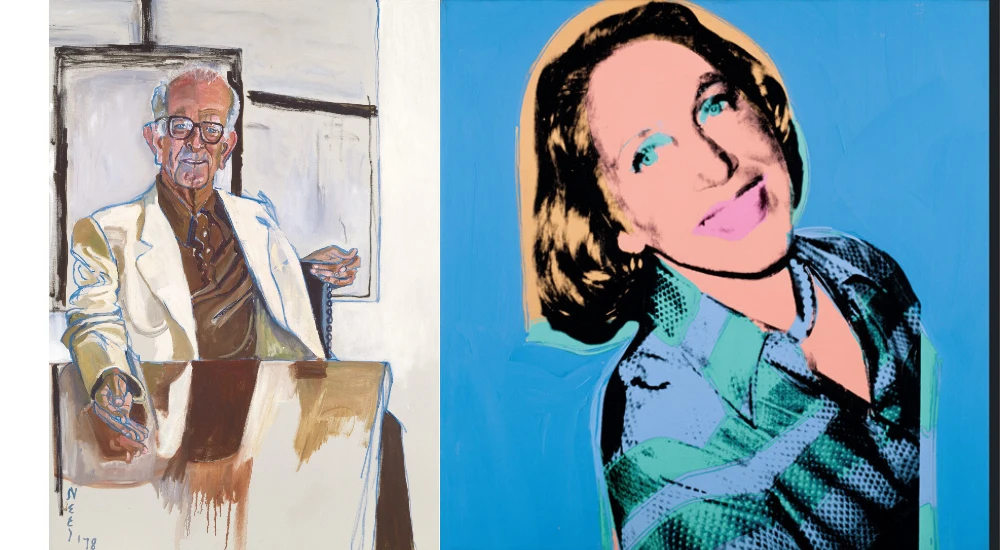

The Seattle Art Museum has provided a spare and spacious setting to present its latest important bequest to the public.
To see the show from the most interesting angle, though, I think visitors need to do some creative imagining of their own. Try to ignore the chaste, neutral museum space; shrink your focus, keep in mind that the 19 works you’ve come to visit were accumulated in just a little more than 10 years and were hung cheek by jowl amid the furnishings of a comfortable but not-palatial private home.
You’ll meet the couple who chose the art you see in person: Jane Lang Davis in an uncharacteristically gentle Andy Warhol silkscreen which captures the woman’s air of wistful curiosity.
Husband Richard is here too, in a rather underdone portrait by “realist” Alice Neel, which nevertheless catches Dick’s edgy energy.
Carry your impression of the couple with you as you view the remarkable assembly of art works which were their everyday home environment. You’ll find connections between artists and images you’d otherwise miss.
See the gaggle of black brushstrokes above Lang’s shoulder in the Neel? You’ll see it life-size when you encounter Franz Kline’s No. 11 nearby, the Langs’ first acquisition as a couple. Robert Motherwell’s Before the Day was painted 20 years after Kline’s rickety ebon framework, but it’s impossible that the Langs didn’t notice how its suggestion of windows opening on (or shutting in) a wash of pallid light seems deliberately to echo the earlier work.
Other coincidences prove uncoincidental. Mark Rothko was still painting in Miro-adjacent subaqueous-organism mode in the Untitled dated 1945. But backgrounding its spindly entities you already find the looming dark bands that define his mature style in the Untitled of 1963.
Sometimes a pair of works can bracket what we think we already know about an artist. Francis Bacon is already deep into his portraiture-as-surgical-procedure mode in 1963’s Portrait of Man with Glasses I, but the small scale of the piece make it look almost puckish.
1967’s Study for a Portrait is larger and much more in the artist’s grand guignol manner, but the corpse-ish “subject” occupies such a chic but sterile studio setting that it doesn’t produce the true Bacon retch-reflex response. (I suspect “study” in this case means “got bored and decided to quit while I was ahead.”)
Many of the Langs’ choices seem deliberately to avoid conventional expectations. The 1948 Village Square by Willem de Kooning is a spidery monochrome-brown almost-landscape that feels like a Breugel winterscape seen from a high angle through a heavy snowstorm.
Most of Clyfford Still’s abstractions feel like close-ups of a volcanic eruption. In the Langs’ PH-338 (1949-No. 2) the lava has cooled at the surface but still grows hot through flakes in it surface.
Almost every piece in this show plays agreeably with its companions (though Giacometti’s small sculpture Femme de Venise II seems a little wan and daunted amid so much virtuosic brushwork).
But Philip Guston’s The Painter, of 1976 sticks out. The critical establishment has forgiven Guston for his rejection of tasteful gnomic abstraction (see To B.W.T., 1952) for sprawling, rude, tasteless, cartoonish and viscerally vital figuration dotted with KKK hoods, empty bottles and cigarette butts.
Seattle art lovers, at least those who turn out for a gallery turn early on a chilly Sunday morning, are still not prepared to cut Guston any slack. I spent about 20 minutes with the ratty old boozer portrayed in The Artist (1976). Nine out of ten people who passed through the room where he hangs barely glanced at him: even the most assiduous text-readers skipped his label.
Guston was still annoying and offending according to informed opinion in 1982, when the Langs bought The Artist. I like to think that’s why they bought him. Dick Lang was a fully-vested member of Seattle high society, but the gleam you see in his eye in Alice Neel’s portrait was a constant presence in the man himself. He saw something in Guston’s dirty old man that rang his bell, and the genteel lady looking at it beside him at New York’s David McKee Gallery that day must have seen it too.
Discover more from Post Alley
Subscribe to get the latest posts sent to your email.

Superb review with observations that are informed, nuanced, keen. Thanks!